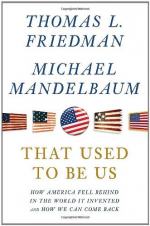
|
| Name: _________________________ | Period: ___________________ |
This test consists of 15 multiple choice questions and 5 short answer questions.
Multiple Choice Questions
1. According to the authors, there are three mindsets when thinking about being a creative creator or a creative server. What is the third?
(a) Think like an immigrant.
(b) Think like a waitress.
(c) Think like an artisan.
(d) Think like a teacher.
2. According to the authors in Chapter 3: "Ignoring Our History," there are five pillars to prosperity that if ignored will be at America's peril. What is the first pillar?
(a) Our infrastructure must be continually maintained and modernized.
(b) Private economic activity must have necessary regulations.
(c) Public education must be provided for more and more Americans.
(d) The doors to immigration must be kept open.
3. What is the trademark of a range of durable, high-performance, polyimide-based plastics manufactured by DuPont?
(a) Nylon.
(b) Neoprene.
(c) Vespel.
(d) Kevlar.
4. What refers to a revolutionary wave of demonstrations and protests occurring in the Arab world that began on December 18, 2010?
(a) Arab Spring.
(b) Arab Vengence.
(c) Arab Freedom Movement.
(d) Arab Awakening.
5. When did Tom Friedman travel to China for the World Economic Forum summer conference?
(a) June, 2009.
(b) August 2011.
(c) September, 2010.
(d) July, 2008.
6. What does NATO stand for?
(a) North Argentinian Treaty Organization.
(b) North American Trade Organization.
(c) North African Trade Organization.
(d) North Atlantic Treaty Organization.
7. What was the large-scale American program to aid Europe where the United States gave monetary support to help rebuild European economies after the end of World War II in order to combat the spread of Soviet communism?
(a) The New Deal.
(b) The Denali Plan.
(c) Washington's Deal.
(d) The Marshall Plan.
8. What is a proprietary voice over Internet Protocol service and software application originally created by David Somekh and owned by Microsoft since 2011?
(a) Facebook.
(b) Skype.
(c) Myspace.
(d) Twitter.
9. A team from what country won the second prize in the the 2011 Association for Computing Collegiate Programming contest?
(a) Australia.
(b) Sweden.
(c) China.
(d) U.S.A.
10. When was Steve Jobs born?
(a) 1961.
(b) 1955.
(c) 1942.
(d) 1948.
11. According to the authors, there are three mindsets when thinking about being a creative creator or a creative server. What is the first?
(a) Think like a waitress.
(b) Think like an immigrant.
(c) Think like an artisan.
(d) Think like a teacher.
12. What refers to the process of thinking that questions assumptions?
(a) Mundane thinking.
(b) Presumptive thinking.
(c) Critical thinking.
(d) Assumptive thinking.
13. The Tea Party movement has sponsored protests and supported political candidates since what year?
(a) 1997.
(b) 2007.
(c) 2002.
(d) 1992.
14. When was the DuPont Corporation founded?
(a) 1802.
(b) 1785.
(c) 1857.
(d) 1833.
15. The Network for Teaching Entrepreneurship first became popular with kids in high crime areas in New York because in addition to teaching them math and reading, it focused on how they could do what?
(a) Make money.
(b) Play sports.
(c) Move away.
(d) Become astronauts.
Short Answer Questions
1. In the context of United States constitutional interpretation, what is a principle of interpretation that tries to discover the original meaning or intent of the constitution?
2. According to the authors, what is the first cause for the decline of America?
3. What is the third major challenge that America faces?
4. Where in China did Tom Friedman attend the World Economic Forum summer conference?
5. What is the third pillar to prosperity?
|
This section contains 592 words (approx. 2 pages at 300 words per page) |

|




